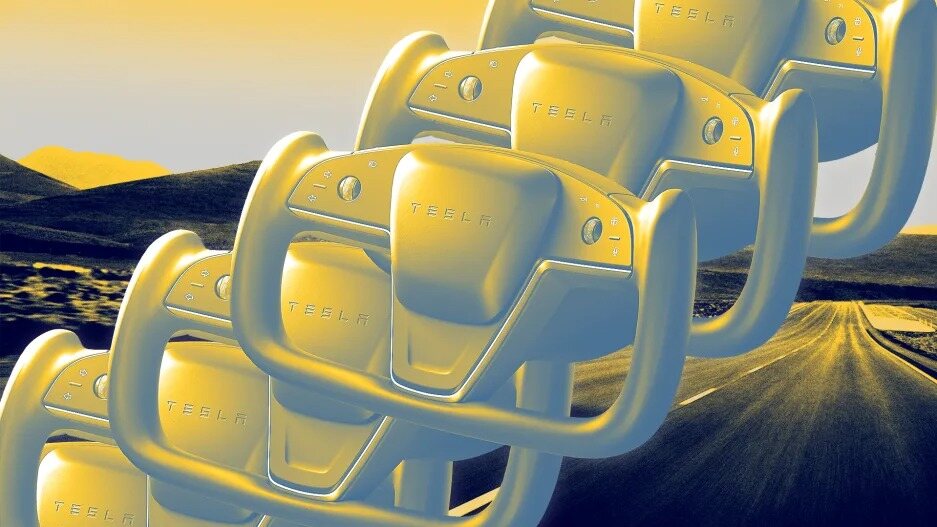- | 12:00 pm
Tesla’s shoddy wheel symbolizes everything that’s wrong with the company
Using seemingly poor materials in the Tesla Model S yoke is just the latest in an endless list of quality assurance roadkill by the Texas car manufacturer.

The Tesla Model S’s infamous yoke is even worse than everyone thought. This half steering wheel—a steering trapezoid, if you will—launched on the $95,000 Model S in 2021. Not only has its design made it extremely difficult to steer when making any kind of low-speed maneuver—but now the yoke is literally falling apart for some customers after as few as 12,000 miles of driving.
The yoke is the perfect symbol of everything that’s wrong at Tesla: luxury cars built with methods and materials that are often mediocre at best.
THE MODEL S YOKE IS A JOKE
If you haven’t actually seen a Model S yet, its new steering wheel is seemingly stolen from KITT, David Hasselhoff’s talking 1982 Pontiac Trans Am in the camptastic Knight Rider TV series. While Lexus uses a similar design, the yoke is almost universally hated by drivers and critics alike—so much, in fact, that it has spawned a third-party market of replacements and thingamajigs, some of them starting at $3,000 a pop.
Now an influx of social posts highlighting the poor quality of the half wheel are coming in fast. Like The Drive reports, it all started with the owner of a Tesla Model S Long Range (priced at $115,000 and up), who saw his yoke starting to disintegrate at the 24,000-mile mark.
A TikTok influencer and owner of a Model S Plaid (starting at $170,000) posted a photo of a missing chunk of material after 12,000 miles. Then, “one mile down the road,” he posted another photo explaining that “it’s already gotten worse.”
TESLA PRODUCTION IS QUALITY ASSURANCE ROADKILL
I have never seen anything like this problem in any car steering wheel I have ever used—and you probably haven’t, either. As car journalist Lewin Day points out in the aforementioned Drive article, “the fundamental truth is that most automakers have found ways to create steering wheel finishes that last for 100,000 miles or more without excessive degradation.”
Day also correctly remarks that “most people expect to be able to live their lives normally without their cars suffering excessive wear from basic activities” like sweating, using hydroalcoholic hand sanitizer or skin lotions, or spilling coffee or soda.
Yet these issues go far beyond the yoke. The fact is that the internet is brimming with videos, tweets, and articles of the poor build and material quality of Tesla’s car, no matter the model. From someone who discovered his Model Y cooling system had been put together with fake wood to reports of doors that don’t shut flush, nuts missing in the front suspension, and missing bolts, the road to Tesla’s success is apparently littered with quality assurance roadkill.
Tons of problems are posted on the boards of the National Highway Traffic Safety Administration (NHTSA), but the overall mediocre or plain bad quality can be summarized by damning videos like the ones that illustrate this article.
The use of poor-quality components like in the yoke is particularly startling for an automaker that sells cars at Porsche-level prices (even if they’re electric). You’ll find similar quality control issues in Tesla’s oversize touchscreens. Tesla had to settle a class-action lawsuit over defective touchscreens that appeared to have malfunctioned because they weren’t rated to sustain the usual temperature swings of a car’s interior.
That touchscreen example—like the missing bolts and nuts—is especially worrying because Tesla’s apparent disregard for quality impacts driver safety. In fact, federal investigators called out Tesla to instill stricter Autopilot safety standards in early 2021, only to be ignored.
THE YOKE IS AN APT METAPHOR FOR TESLA’S PROBLEMS
If you think these are just a few whiners on the internet or an overzealous federal authority trying to destroy Musk’s stellar reputation, just keep in mind that Tesla came second to last in Consumer Reports’s 2021 car reliability survey.
To paint a full picture of just how unreliable a Tesla can be, a friend who has owned a Model 3 for four years just shared a full history of needed repairs since buying the car new: a broken chair adjustment, three car computer swaps, two 12-volt battery swaps, two incidents of audio system failure, a window that didn’t roll up after an unrelated service repair, a broken in-cabin camera, a charge port that didn’t close properly, one AC filter swap because of mildew smell, and, the worst of all, three times the car powered down for no reason while driving.
Oh, and the seat belt was not installed correctly two times after a fix. Tesla’s errors beget more errors.
In the end, it feels to me like we have the perfect metaphor for both Tesla’s quality problems and its founder’s erratic vision, poor direction, and broken promises. Elon Musk is vowing to deliver the world’s first completely autonomous car, all while he’s still figuring out how to build the steering wheel.








































